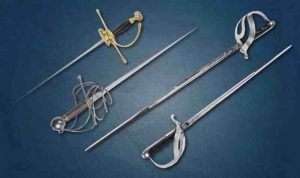When building a bladesinging wizard in DnD 5e, consider the following features:
- Try a high elf or feral tiefling build.
- Wizard basics: Arcane Recovery, Spell Mastery, Signature Spells.
- Bladesinging abilities: Bladesong, Training in War and Song…
- Choose spells for swordplay: booming blade, green-flame blade…
- Multi-class potential: Battle Master, Swashbuckler, College of Swords
The bladesinging wizard in Dungeons and Dragons 5e mixes the study of magic with graceful swordplay. This character is an intelligent fencer or noble, a class born of elves. Therefore, I’ll have an opportunity to be a smug outcast or an honorable prince. Either way, I’ll have the benefits of the wizard spell list and a roguish ability with the blade.
Try a high elf or feral tiefling build.
Because this wizard thrives on magic and maneuverability, I’ll want a race that adds Dexterity and Intelligent bonuses.
High elves come with a +2 Dexterity/+1 Intelligence ability score bonus and a handful of elvish abilities. Fey Ancestry gives me advantage against being charmed and immunity to being put to sleep with magic. Plus, I’ll get a bonus cantrip. Naturally, I could roleplay this character as a noble.
On the other hand, feral tieflings also add a +2 Dexterity/+1 Intelligence ability score bonus, but with fiendish spells built in. I’ll have Hellish Resistance (fire resistance), along with thaumaturgy, hellish rebuke (2d10 fire damage against foes who hit me) and darkness as I level up to 5.
Wizard basics: Arcane Recovery, Spell Mastery, Signature Spells.
Before I get into spells and swordplay, let’s take a look at basic wizard class features.
Arcane Recovery is a wizard ability that grants me some of my spent spell slots on a short rest. The amount of spell slots I recover is equal to half my wizard level rounded up. This ability comes at level 1.
However, the next wizard class ability, Spell Mastery, comes at level 18. Spell Mastery gives me a 1st-level and 2nd-level spell to cast for free once a day and always have prepared.
Finally, Signature Spells (level 20) gives me a free 3rd-level spell to cast for free once a day.
Related Posts:
Guide to Building a Tiefling Hexblade Warlock
| Guide to Building a Bard College of Swords: DnD 5e
|
Bladesinging abilities: Bladesong, Training in War and Song…
At level 2, I truly begin my bladesinging journey with Training in War and Song and Bladesong. Now, I’m transforming into much more of a magical swordfighter than a run-of-the-mill wizard in robes.
Training in War and Song gives me proficiency with light armor and one type of one-handed melee weapon of my choice. Plus, I’ll gain proficiency in Performance if I don’t already have it. As far as the weapon goes, I want to lean into my high Dexterity score and use a rapier or katana (finesse) for 1d8 piercing or slashing damage.
Then, Bladesong evokes an elven magic that grants me several benefits for 1 minute. However, I can only use this ability an amount of times equal to my proficiency bonus.
- I gain a bonus to my AC equal to my Intelligence modifier.
- My walking speed increases by 10 feet.
- I have advantage on Dexterity (Acrobatics) checks.
- I gain a bonus to any Constitution saving throw I make to maintain my concentration on a spell.
By level 6, I’ll gain the fighter-like ability Extra Attack, giving me the ability to attack twice when I take the attack action.
Song of Defense (level 10) transforms spell slots into damage reduction. Whenever I’m struck with an attack, I can spend one spell slot to reduce the damage by 5 X spell slot level.
Finally, Song of Victory (level 14) adds my Intelligence modifier to the damage of my melee weapon attacks while my Bladesong is active.
Choose spells for swordplay: booming blade, green-flame blade…
Along with this bladesinging class, Tasha’s Cauldron of Everything introduces a number of spells that fit this build well.
Cantrips
Most of my unique sword spells come as cantrips.
- Booming Blade: When I hit an opponent with a sword strike, an electric, booming energy covers their body. Until my next turn, they take 1d8 thunder damage if they move 5 feet. When I reach level 5, I can add 1d8 extra thunder damage to the strike. Both abilities increase in damage as I level further.
- Green-Flame Blade: On a successful melee strike, I can deal extra fire damage to an adjacent opponent within 5 feet of the first. At level 5 I deal extra 1d8 fire damage on a hit. The fire damage also increases by 1d8 + Intelligence modifier for the 2nd Again, both damage opportunities increase as I level.
- Sword Burst: I create a circle of spectral blades that deal 1d6 force damage to enemies within 5 feet of me who fail a Dexterity saving throw. This damage increases by 1d6 when I reach level 5, 11 and 17.
- Mage Hand: A spectral hand reaches out 30 feet to inspect objects, open doors, disarm or trigger traps and many other creative uses.
1st-level spells
With most of my cool sword moves out of the way, I can use 1st-level spells for ranged attacks and classic wizard options.
- Chromatic Orb: Hurl a small orb or energy as a spell attack. On a hit, the orb deals 3d8 damage of a type I choose (acid, fire, cold, thunder, lightning or poison). Now, I have a versatile ranged attack for different foes.
- Shield: As a reaction, I gain +5 to my AC until the start of my next turn. Plus, I’m immune to magic missile. With a higher AC than most wizards, this effect will be incredibly useful.
- Detect Magic: I can pick up on magical energies, knowing what direction they are coming from and what school they belong to.
- Protection from Evil and Good: Touching a target, I cause protection against aberrations, celestials, elementals, fey, fiends, and undead. These creatures have disadvantage on attacks against the target, and the target is immune to being charmed or frightened.
2nd-level spells
Again, I’ll tap into classic wizard favorites for my 2nd-level spells, with an added effect-based spell from Tasha’s Cauldron of Everything.
- Misty Step: I can teleport up to 30 feet away in a cloud of silver mist.
- Invisibility: Target I touch magically turns invisible for up to an hour. The spell ends if the target attacks or casts a spell.
- Tasha’s Mind Whip: Target within 90 feet must make an Intelligence saving throw or take 3d6 psychic damage. Plus, the target can only move, take an action or take a bonus action (instead of all 3 per usual).
3rd-level spells
Now, I get to tap into summoning spells and effective counter-magic.
- Counterspell: As a reaction, I can automatically counter 3rd-level spells and lower. Higher-level spells cause me to make an Intelligence check with a DC equal to 10 + spell’s level.
- Dispel Magic: Choose a creature, object or magical effect. Any spell of 3rd level or lower automatically ends on the target. Again, I’ll need to make a successful Intelligence check with a DC equaling 10 + spell level.
- Summon Fey: This fey spirit is armed with a shortsword and takes its turn directly after mine. This shortsword attack roll equals my Intelligence modifier to hit, dealing 1d6 + 3 + spell’s level piercing damage + 1d6 force damage. Plus, this little guy can teleport, gain advantage on attacks, charm enemies and cast magical darkness as bonus actions.
Related Posts:
The Best Swordsmen and Women of All Time: Movies/TV
| Guide to Building Puzzles in Campaigns: DnD 5e
|
Multi-class potential: Battle Master, Swashbuckler, College of Swords
Because my primary sword abilities and spells come at level 2 for this class, I have a large amount of potential for multiclassing a unique sword fighter.
Three levels of the fighter class will give me the battle master subclass. With this class, I can upgrade my armor, and gain Action Surge and Second Wind for added melee abilities. Plus, I’ll be able to choose 3 maneuvers to add to my sword fighting prowess. The maneuver I love the most is Riposte, which grants me a free attack against enemies who attack and miss me.
However, swashbuckling rogues can lean into Sneak Attack, Expertise and thieves’ tools for a cunning sword fighter. Fancy Footwork grants me the ability to move out of melee range without taking an attack of opportunity. Partner this ability with booming blade, and I can tempt enemies into chasing me and take thunder damage. Plus, Rakish Audacity gives me Sneak Attack without the need for advantage—essentially adding tons of extra damage in an up-close sword fight—and a bonus to my Initiative equal to my Charisma modifier. If another creature is within 5 feet of me, I’ll lose the Sneak Attack ability. Therefore, this is more of a one-on-one situation.
Finally, the bard College of Swords gives me Bardic Inspiration dice to help friends with attack rolls, ability checks and saving throws. Plus, I’ll gain Jack of All Trades and Expertise to boost my overall skills. However, the College of Swords gives me the opportunity to use this Bardic Inspiration for special sword attacks called Blade Flourish. Now, I’ll have options for Defensive Flourish, Slashing Flourish and Mobile Flourish with corresponding sword effects.






